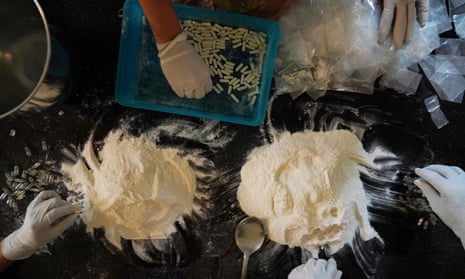For a few days in April, news sites across Latin America were running Instagram photos of a glamorous blond woman enjoying trips around the world.
There were pictures of Ana Gabriela Rubio Zea, 32, posing in a blue dress and Yves Saint Laurent handbag outside San Miguel de Allende, ice skating in a miniskirt in Central Park and laughing in the Forbidden City.
The social media images were then followed by more recent photos: Rubio, in a sweatshirt and jeans, flanked by officers from the national civil police of Guatemala, where she was arrested on 17 March for her alleged role in sourcing fentanyl precursor chemicals from China for the Sinaloa cartel.
According to the arresting agency and a federal indictment released on 14 April, for almost 10 years Rubio arranged illegal imports of controlled drug-making substances, sometimes hiding them in food containers and leveraging corruption to deliver the chemicals to the cartel.
“We are the biggest in Mexico so we can purchase a lot,” the indictment quotes Rubio telling Wu Yonghao, a sales representative for the chemical supplier Wuhan Shuokang Biological Technology Co Ltd, in an encrypted message before her arrest.
A new crackdown
The US attorney general, Merrick Garland, called the Mexico-based Sinaloa cartel “the largest, most violent, and most prolific fentanyl trafficking operation in the world” in a statement accompanying the sweeping indictments covering cartel bosses, enforcers and suppliers such as Rubio and Wu.
The pair are just two links in a chain connecting the Sinaloa cartel to Chinese companies and criminal organizations, relationships that are now drawing increasing attention from the US government after years of investigation by law enforcement.
On 9 May, three weeks after the US Department of Justice issued the sweeping indictments that caught Rubio and Wu in their net, the US treasury department followed up with sanctions against Joaquín Guzmán López, 36, one of the four sons of the Sinaloa cartel founder, Joaquín “El Chapo” Guzmán Loera, who have amassed power and steered the cartel into the fentanyl trade since their father’s last arrest.
The sanctions notice identified the younger Guzmán as a manager of the cartel’s “super labs”, which turn precursors bought from China and elsewhere into fentanyl.
Chinese officials have repeatedly denied any nexus between China and illicit fentanyl, often touting their country’s leadership as the first to schedule the opioid as a narcotic. In April, a Chinese foreign ministry spokesperson said Mexico had yet to notify China that it had seized any illegal precursor shipments.
Yet the evidence of the relationship between the cartel and Chinese entities is not new. US law enforcement and government agencies including the Drug Enforcement Administration, the FBI, the Department of Homeland Security and the military have all tracked the cartel’s supply chains and money-laundering networks as they expanded into China almost a decade ago.
Now, deepening antipathy between Washington and Beijing, driven by accusations of intellectual property theft and spying, as well as geopolitical strains from issues such as Taiwan and the war in Ukraine, appear poised to spark action from Capitol Hill.
It is progress that a former DEA assistant special agent in charge, Christopher Urben, is eager to see.
“We’ve talked a lot in the last 10, 15, 20 years about the ‘whole-of-government approach’. There are different authorities within our agencies and expertise. If you synchronize those efforts against Chinese organized crime and money laundering specifically, you could dramatically impact them,” said Urben, now a managing director at the investigation firm Nardello & Co. “It’s a scaling-up of those resources and it needs to happen now.”
Providing the cartel’s ‘lifeblood’
When fentanyl first started appearing in street drugs, it was almost all sourced from China, arriving in the US via “snail mail”, according to Channing Mavrellis, illicit trade director at Global Financial Integrity, a DC-based thinktank.
“This was originally just a way of [stretching things when] they were low on product,” said Mavrellis. “Now it’s ‘Hey, people are responding really well to this’ – for better or for worse.”

According to the DEA and the justice department, since at least 2019 the bulk of the illegal fentanyl entering the US has been produced in Mexico using Chinese precursor chemicals.
But the cartel’s ties to China do not end there. On 26 April, Mavrellis and Urben both testified at a US House of Representatives subcommittee hearing titled China in Our Backyard: How Chinese Money Laundering Organizations Enrich the Cartels.
“Money is the lifeblood of the cartels, and the methods that Chinese [organized crime] was using enriched them and enabled them to traffic even more fentanyl and other deadly drugs into the United States,” Urben told lawmakers at the hearing.
Digitally connected criminals
In an interview after the hearing, Urben recounted shifts in New York’s drug trade around 2016, when couriers for Chinese money-laundering organizations started showing up at money drops in his zone. Business was booming for drug cartels in his jurisdiction and everywhere else in the US, as more people got hooked on fentanyl and overdose deaths climbed.
In 2014, fewer than 6,000 people died from synthetic opioid overdoses in the US, according to data from the Centers for Disease Control and Prevention. By 2021, the last full year of available data, that figure topped 71,000, or almost 200 people pera day on average.
In the years leading up to the Covid-19 pandemic, Urben said his team could hardly keep tabs on one drug transaction without stumbling upon another.
“You would be out in Flushing, Queens … targeting one group,” said Urben. “The street activity related to these organizations was so significant that you wound up watching handoffs on the same street.”
The handoffs themselves changed once Chinese money-laundering organizations took over. Previously, the drug traffickers and the money brokers they contracted to wash their proceeds both treated exchanges as high-stakes events prone to theft or law enforcement busts, deploying counter-surveillance and taking pains to stay anonymous through the planning and execution of the drop.
Now, they have WeChat and other encrypted apps based overseas, which are outside the reach of US warrants.
“We can’t wiretap it,” said Urben. “We can’t do anything with it.”
WeChat’s website states that the company provides “non-public customer information in response to law enforcement requests when legally required to do so”.
Getting the information is only part of the battle, according to Tom Cindric, a veteran of the DEA’s special operations division, who echoed Urben’s frustrations, calling for more collaboration across agencies to help agents address the challenges posed by the app.
“There’s nobody to interpret it,’” he said.
Providing a private line between the cartel and its money brokers, the app also introduced a new level of trust, according to Urben. Gone are the days of burner phones, which changed constantly and meant you never really knew who was on the other end of the call.
“WeChat handles stay consistent over time” he said, which offers cartel operatives “a certain comfort level”. Moreover, the technology allows criminals to coordinate meetings and money transfers instantaneously. “That didn’t happen in the past,” Urben emphasized.
A new business model
Unlike their predecessors, Chinese money-laundering organizations have little interest in charging the cartel a fee for their services. Instead, they’re after the bulk cash itself. Advertising the dollars on WeChat or other platforms, they sell the cash to Chinese nationals at a premium.
Laws China introduced in 2015 to stop money from flowing out of the country have created a huge market of Chinese nationals who are looking to spend money in the US on big ticket purchases, such as real estate and college tuition, but are unable to move their money out of China.
The way the criminal organizations operate, no yuan leaves China. Instead, the person buying the dollars sends payment to the seller’s Chinese account, and collects the cash they bought in person in the US.
The cartel also gets paid instantly, rather than waiting weeks as it did in the past, while brokers turn dollars into pesos by physically exporting goods from the US and providing the cartel with the proceeds once those goods are sold in Mexico.
While Mavrellis and Urben came away from their hearing encouraged that the representatives seemed eager to weed fentanyl proceeds out of the US financial system, Cindric said he was skeptical that lawmakers were motivated to avenge the people most affected by the fentanyl crisis.
“Congress doesn’t care. I think they [view] the people who die as just a few addicts, and I think they get marginalized,” he said “I don’t believe Congress cares at all.”
